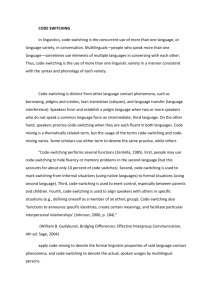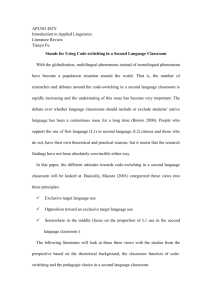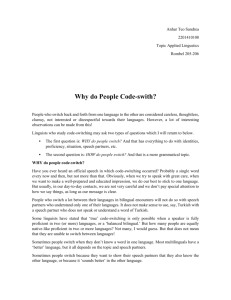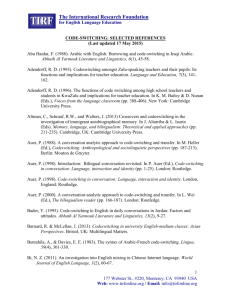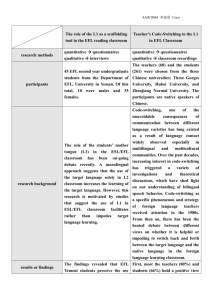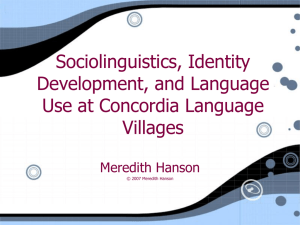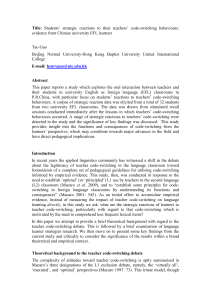3.Investigating Teacher Code
advertisement
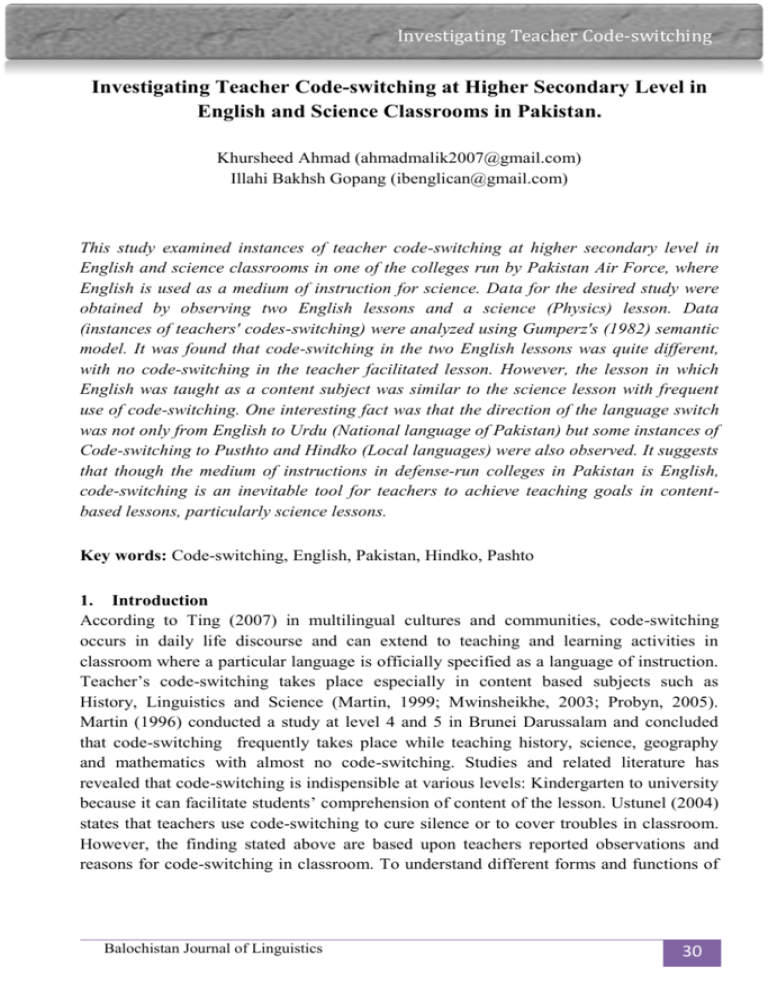
Investigating Teacher Code-switching
Investigating Teacher Code-switching at Higher Secondary Level in
English and Science Classrooms in Pakistan.
Khursheed Ahmad (ahmadmalik2007@gmail.com)
Illahi Bakhsh Gopang (ibenglican@gmail.com)
This study examined instances of teacher code-switching at higher secondary level in
English and science classrooms in one of the colleges run by Pakistan Air Force, where
English is used as a medium of instruction for science. Data for the desired study were
obtained by observing two English lessons and a science (Physics) lesson. Data
(instances of teachers' codes-switching) were analyzed using Gumperz's (1982) semantic
model. It was found that code-switching in the two English lessons was quite different,
with no code-switching in the teacher facilitated lesson. However, the lesson in which
English was taught as a content subject was similar to the science lesson with frequent
use of code-switching. One interesting fact was that the direction of the language switch
was not only from English to Urdu (National language of Pakistan) but some instances of
Code-switching to Pusthto and Hindko (Local languages) were also observed. It suggests
that though the medium of instructions in defense-run colleges in Pakistan is English,
code-switching is an inevitable tool for teachers to achieve teaching goals in contentbased lessons, particularly science lessons.
Key words: Code-switching, English, Pakistan, Hindko, Pashto
1. Introduction
According to Ting (2007) in multilingual cultures and communities, code-switching
occurs in daily life discourse and can extend to teaching and learning activities in
classroom where a particular language is officially specified as a language of instruction.
Teacher’s code-switching takes place especially in content based subjects such as
History, Linguistics and Science (Martin, 1999; Mwinsheikhe, 2003; Probyn, 2005).
Martin (1996) conducted a study at level 4 and 5 in Brunei Darussalam and concluded
that code-switching frequently takes place while teaching history, science, geography
and mathematics with almost no code-switching. Studies and related literature has
revealed that code-switching is indispensible at various levels: Kindergarten to university
because it can facilitate students’ comprehension of content of the lesson. Ustunel (2004)
states that teachers use code-switching to cure silence or to cover troubles in classroom.
However, the finding stated above are based upon teachers reported observations and
reasons for code-switching in classroom. To understand different forms and functions of
Balochistan Journal of Linguistics
30
Investigating Teacher Code-switching
code-switching which takes place inside classroom, classroom observation to record
naturally occurring instances of code-switching will provide a better understanding of the
phenomenon of code-switching. Generally Gumper’z (1982) model which was designed
for the study of understanding of social and cultural meaning of language is the best
approach (Nilep, 2006).
1. Gumper’z Model and Students Code-Switching
In classroom environment, Gumper’z model is found useful for the study of use of codeswitching by students and teachers. Choi and Kuipers (2003) studied the conversation of
two bilingual Hispanic and two monolingual English students in a chemistry class. They
found that Hispanic students while explaining a procedure of a problem, switched
between English to Hispanic and from Hispanic to English to clear the procedure. They
switched their code many times for the sake of quoting and stressing an idea. Similarly
Zing (2009) conducted a study in Melbourne to examine code-switching among 30
Chinese students ranging from age six to eight. The interviewer used Chinese only as the
language of interview while students switched between English and Chinese when
responding to the questions. It was thus concluded that the situational switch may occur
due to a change in context.
2. Teachers Code-Switching
We have seen that Choi and Kuipers (2003) and Zheng (2009) conducted studies about
code-switching at student’s level; however other researchers took interest in codeswitching taking place at teachers’ level. The major study regarding teachers’ code –
switching was conducted by Mahadhir and Then (2007) examined code-switching done
by Nine- pre service teachers in their classrooms in Malaysia. Code switching mostly
takes place for calling attention and personalization in the classroom. Moreover codeswitching is done for the sake of making the students to understand the content as well
the vocabulary. In another study which was conducted by Seidlitz (2003) in Germany on
five American teachers and three German teachers. It was found in the study that
American teachers had more situational switches than the native German teachers.
Moreover it was found that reiteration of the German teachers was more frequent than the
American teachers while the reiteration of the American teachers was lengthier than the
German teachers. The American teachers used the German language first and then
explained that concept in English while for the German teachers the matter was totally
reversed because they used English first and then explained that concept in English. The
American teachers used to switch when they thought that students would misunderstand
the concept on the hand German teachers used to speak in the language which students
demand them to speak in. American teachers used English for humour, praise and
courage while the German teaches did that in reverse. All the above studies confirmed
that code- switching took place in classrooms at student’s level as well as teacher’s level.
Balochistan Journal of Linguistics
31
Investigating Teacher Code-switching
Code-switching can be defined as the use of more than one code or language in the
course of a single speech event (Gumperz, 1982), taken to refer to teacher utterances in
the classroom for this study This study examines the discourse functions of teacher codeswitching in secondary school English and science classrooms in Pakistan.. The teachers'
use of code-switching to convey meanings to students was analysed using Gumperz's
(1982) semantic model of conversational code-switching. In this paper, I show that it is
the content knowledge or language focus of the lesson that influences the discourse
functions of choice of the "official" language of the classroom or other languages. The
findings point to selected code-switching functions being useful for teachers to achieve
teaching goals in classrooms where lack of proficiency in the instructional language
might compromise learning.
3. Research Site
The setting for the study is Pakistan. The study was conducted in three different classes at
Investigating Teacher Code-switching
PAF Inter College Kohat. National language of Pakistan is Urdu however; the medium of
instruction at the above mentioned college is English because it works under Pakistan
Airforce. The majority of students can understand English easily but only a handful is
able to speak correctly and efficiently.
3.1. Participants
The participants were two English teachers and a Science teacher with masters in their
respective fields with more than 10 years teaching experience and equally fluent in
English and Urdu.
3.2. Data Collection
For the purpose of comparing the nature of code-switching in science and English
lessons, two lessons were selected from a corpus of English lessons. The first was a
lesson with frequent code-switching. For contrast, a second English lesson with few
instances of code-switching was selected. The classroom data for the science teacher
were collected as part of a larger study. Prior to the data collection, verbal consent was
sought from the teachers and they were requested to audio-record a single 50-minute
lesson. Total recorded duration for each class was 200 minutes i.e. four classes each
teacher. The transcripts were analysed for code-switching functions using Gumperz's
(1982) semantic model encompassing situational and metaphorical code-switching.
4. Results and Discussion
This section presents the results on code-switching in the English and science lessons.
Table 1 is the expression of a number of code-switching instances took place during three
lessons i.e. two content based lessons; English and Science and one English language
lesson.
Balochistan Journal of Linguistics
32
Investigating Teacher Code-switching
Table 1. Frequency of Teacher Code-switching in the English and Science Lessons
Lesson
Topic
Code-switching instances
English 1
The poem: One way of Love
18
English 2
The Stuffed Trout
5
Science 1
Sample machine: Lever
20
Total
43
The results show that there were 43 instances of code-switching in form of phrases,
sentences and sometimes words, in the three lessons combined (Table 1), involving
mainly English and Urdu. Both the science teacher (n=20) and English Teacher 1 (n=18)
code-switched frequently during the lesson but English Teacher 2 code-switched very
little when he taught reading skills (n=5). The frequency does not take account of the
word "Okay" as an example of code-switching as it may not be considered as an English
word any longer.
Table 2. Frequency of Code-switching Functions in Science and English Lessons
Functions of Code-switching
Science
English 1
English 2
Total
%
Reiteration
8
9
0
17
39.53
Message Qualification
10
6
0
16
37.20
Interjections
2
1
0
3
6.97
Quotations
0
0
03
3
6.97
0
0
02
2
4.65
Addressee specifications
0
01
0
1
2.32
Situational code-switching
0
1
0
1
2.32
Total
20
18
05
43
99.96*
Personalization and Objectivisation
Table 2 shows that the most common discourse functions of code-switching were
reiteration (39.53%) and message qualification (37.20%), and these were used only by
the science teacher and English Teacher 1.For example, English Teacher 1 said
Balochistan Journal of Linguistics
33
Investigating Teacher Code-switching
[reiteration(Mukhtasaran ('as a whole') to sum up his explanation on point of view in a
poem. Similarly, the science teacher said samajh ayi? ('got it?')]. Similarly Jeffery
Chaucer, [Messag Qualification(Jo k Angrezi shairi ka baba he) wrote Prologue to the
Canterbury Tales.
4.1. Teacher-fronted Content Lessons
The science lesson was conducted in class with a simple teacher demonstration of the
Investigating Teacher Code-switching
operation of levers. It was not a laboratory session where students had hands-on
experience experimenting with the three types of levers. The science teacher began the
lesson by explaining the working of a simple lever. He initially explained the essential
elements of a lever (load, effort, and fulcrum) in English and reiterated the explanation in
Urdu. He also elaborated on his explanation by interspersing the use of English and Urdu.
The alternation of reiteration and message qualification is illustrated in examples given
below.
In English it is called fulcrum which is represented by F. [Reiteration (isy F sy zahir kya
jata hai)]
To life a load you need to exert some force. [ Message qualification (ksi bhe cheez ko
uthany k ly kowat ki zarurat hoti hai) Hindko Language - Appny hth nal ye ksi hor shai
dy)]
It consist of three parts : you must have a fulcrum, load and force [ Reiteration ( yani
teen chezain zaruri hai ek fulcrum dosra wazan aur kuwat)]
The force end should be longer then a load end [Message qualification (yani agar
wazan ka bazoo 2 inch ho to kuwat ka bazu 4 inch hona chahye)
Example 1.
In this example, the science teacher uses using English to explain how effort needs to be
exerted for a lever to lift a load while resting on a fulcrum. He reiterated by translating it
to Urdu (Kisi bhe cheez ko uthanay k ly takat ki zrurat hot hai). He went on to qualify
what he meant by making a reference to the students' force and load/object (kisi cheez
yaw azan to uthany k ly hm force yani kuwat ka istemal kerty hai). Following this, the
science teacher talked about the three parts of a lever again and immediately reiterated
the concepts in Urdu. This pattern of alternation between reiteration and message
qualification with the message first given in English and then Urdu seemed to have
worked for the science teacher because he used this pattern throughout the lesson. The
use of English seemed to be a launching pad for the explanation in Urdu, considered as
Balochistan Journal of Linguistics
34
Investigating Teacher Code-switching
the part that students could grasp. This tendency arose from his use of English as the base
instructional language for the science lesson, in compliance with government/ Armed
forces language policy. However, the science teacher had to code-switch to Urdu during
the lesson because his students complained that they could not understand a new topic if
he used only English--and this was from a class considered the second best in the school.
Technical vocabulary was a problem. To familiarise his students with the key terms for
the topic (i.e. fulcrum, effort, and load), he embedded the English lexical items in the
Urdu discourse, similar to linguistic strategies used by two English teachers in Martin's
(2005) study in two Malaysian schools.
English Lesson 1 was about a literary element of a poem, the point of view used by the
writer of the poem, making it a content-oriented language lesson. English Teacher 1
began the lesson by reviewing what was taught in the previous lesson about central idea
and individual thoughts in the poem before introducing the notion of "first person" and
"third person" point of view, which was reiterated with a translation into Urdu to help
students draw upon their background knowledge. English Teacher 1 proceeded to cite
evidence from the poem (e.g., the use of "I") to show that it was the poet expressing his
feelings using the first person point of view. When asked whether they understood, the
students replied in no, after which he made another attempt to re-explain "point of view",
and this time beginning with Urdu, as shown in example below:
What is a point of view?
A person who is speaking in the poem [ Reiteration (jo shakhs kisi bhe nazam ya ghazal
me bol raha ho)] who do you think is speaking in this poem? [ Message qualification
(Robert Browning jo k is ka shair bhe hai khud bol raha hai)]
You can see that poet himself speaks that’s why it is called first person point of view.
Robert Browning is an optimist [Reiteration (masbat soch wala , perumeed batain kerny
wala)]
The poet is expressing his internal feelings about love [Message qualification ((Pashto
language) laka khpal da zra khabara wayi mung ta)]
4.2. Teacher-facilitated English Lesson
In contrast to the teacher-fronted science lesson and English Lesson 1, where teacher acts
Investigating Teacher Code-switching
like a leader or to be more precise a dictator, English Teacher 2 facilitated a reading
lesson by asking students questions and building on their responses. Only Five instances
of code-switching were identified (Table 2). This section describes the functions of code-
Balochistan Journal of Linguistics
35
Investigating Teacher Code-switching
switching which could occur despite the teacher's attempt to keep to an English-only
lesson. In this lesson on The Stuffed Trout, English Teacher 2 began by asking students to
look at a picture on The Stuffed Trout, and state the gist of the story. After an effortful
sixteen-turn attempt, a student finally said, big lies. The teacher prompted for the
meaning but inferring big lies from contextual clues proved too difficult for the students.
Realizing the complexity of the task, he called upon a student to role-play the scenario in
the picture with him to explain its meaning. This time he was successful and students
responded with laughter and side remarks. He went on to ask the students about the
number of characters in the dialogue, their identity, their relationship with one another,
and the real life context of the scenario before getting students to role play two scenes
based on the dialogue. Throughout the lesson, English Teacher 2 said only two nonEnglish words, the first was initiated by him and the second by his student. After giving
students some time to read the dialogue, he repeatedly asked the students if they had
finished, only to be met with silence and soft replies of "yes". So he said, "Why? Why do
you all not want to answer me? You are afraid or what?" the teacher got angry and said “
if you don’t answer me , I will make you dadu. The closest translation of "I will make
you dadu" in this context is "I will mak mp like frog" but the Urdu word carries the
meaning of getting the person into trouble and pain. In this context, English Teacher 2
stated his observation of the students' silence in response to his question, and proceeded
to make a guess that the students did not want to answer in case he called upon them to
answer the questions that follow. We coded this instance of code-switching as
personalization, where the personal opinion of English Teacher 2 is indicated and where
the teacher used his personal influence in the form of a threat. The personalization
strategy worked and the students were more responsive after that. The other incidences of
code-switching by English Teacher 2 happened on another occasion when he was
illustrating what a conversation was. He gave an example of a conversation starter as
"how are you today?" and instructed a student to answer him. A student unexpectedly
answered "thak gya ho sir" ('got tired, an example of reiteration.
5. Conclusion
The above results clearly confirms that in Pakistani deference- run colleges, codeswitching takes place most frequently in content based lessons than those lessons in
which content is not supposed to be conveyed to the students rather the focus is on
listening or speaking skills. Moreover, teachers use local languages to make his/her
students understand the concepts. The use of code-switching is made to ensure the
content to be comprehend by the students for whom it is meant while in those lessons in
which content is not meant to be conveyed, a very few instances of code-switching were
observed in defense colleges of Pakistan.
Balochistan Journal of Linguistics
36
Investigating Teacher Code-switching
References
Choi, J., & Kuipers, J. (2003). Bilingual practices in a science classroom: Bilingual Hispanic
students' ways of constructing school science. Retrieved March 28, 2006, from
http://www.gwu.edu/~scale-up/EQRE.doc
Mahadhir, M., & Then, C. O. (2007). Code-switching in the English language classrooms in
Kuching secondary schools. Sarawak Museum Journal, Special Issue No. 7 on Social
Sciences and Humanities, LXIV(85), 197-219.
Martin, P. W. (1999). Encounters of a bilingual kind: Interactional practices in the primary
classroom in Brunei. International Journal of Educational Development, 19, 127-140.
Martin, P. (2005). "Safe" language practices in two rural schools in Malaysia: Tensions between
policy and practice. In M. Y. Lin & P. W. Martin (Eds.), Decolonisation, globalization:
Language-in-education policy and practice. New perspectives on language and education
(pp. 74-97). Cleveland: Multilingual Matters.
Mwinsheikhe, H. M. (2003). Using Kiswahili as a medium of instruction in Tanzania secondary
schools as a strategy of improving student participation and performance in science.
Journal of Instruction in Tanzania and South Africa, 129-148. Nilep, C. (2006). "Code
Switching" in sociocultural linguistics. Colorado Research in Linguistics, 19(1).
Retrieved
June
19,
2009,
from
http://www.colorado.edu/ling/CRIL/Volume19_Issue1/paper_NILEP.pdf
Investigating Teacher Code-switching
Probyn, M. J. (2005). Learning science through two languages in South Africa. In J. Cohen, K.
T. McAlister, K. Rostlad & J. MacSwan (Eds.). Proceedings of the 4th International
Symposium on Bilingualism. Somerville, MA: Cascadilla Press.
Seidlitz, L. M. (2003). Functions of codeswitching in classes of German as a foreign language.
Unpublished doctoral dissertation, University of Texas, Austin.
Ting, S. H. (2007). Influence of ethnicity and hierarchical status on language choice in a
multilingual organization in Sarawak. Sarawak Museum Journal, Special issue No. 7,
LXIV(85), 221-250.
Ustunel, E. (2004). Preference organization in learners' language choice following teacherinitiated and teacher-induced code-switching in Turkish EFL classrooms.
Zheng, L. (2009). Living in two worlds code-switching amongst bilingual Chinese-Australian
children. Australian Review of Applied Linguistics, 32(1), 5.1-5.18. DOI:
10.2104/aral0905.
Balochistan Journal of Linguistics
37
